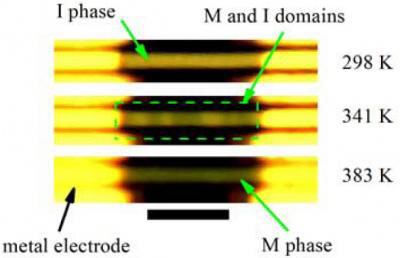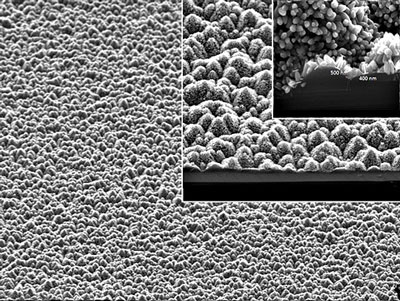University of Wisconsin-Madison researchers are making incremental but important strides in the fuel cell technology that could make clean cars a reality.
Sep 17th, 2009
Read more
For the first time, MIT scientists have observed ferromagnetism in an atomic gas, addressing the decades-old question of whether gases could show properties similar to a magnet made of iron or nickel.
Sep 17th, 2009
Read more
Carmen Lilley, assistant professor of mechanical and industrial engineering at the University of Illinois at Chicago, is working on new procedures for making nanowires more electrically stable - and hence more reliable. She was recently awarded a $505,532 National Science Foundation Faculty Early Career Award to help advance her project.
Sep 17th, 2009
Read more
 In finally answering an elusive scientific question, researchers with the U.S. Department of Energy's Lawrence Berkeley National Laboratory (Berkeley Lab) have shown that the selective placement of strain can alter the electronic phase and its spatial arrangement in correlated electron materials.
In finally answering an elusive scientific question, researchers with the U.S. Department of Energy's Lawrence Berkeley National Laboratory (Berkeley Lab) have shown that the selective placement of strain can alter the electronic phase and its spatial arrangement in correlated electron materials.
Sep 17th, 2009
Read more
An interdisciplinary team of researchers at the University of Delaware has received a two-year $200,000 grant from the National Science Foundation's Nanotechnology Undergraduate Education (NUE) in Engineering Program.
Sep 17th, 2009
Read more
Vom 21. bis 24. September 2009 findet in Dresden die 31. Jahrestagung der Fachgruppe Magnetische Resonanzspektroskopie der Gesellschaft Deutscher Chemiker (GDCh) statt.
Sep 17th, 2009
Read more
Auto researchers and engineers are examining the use of lighter-weight materials and components in their quest to develop more fuel-efficient vehicles.
Sep 17th, 2009
Read more
Researchers at The University of Texas at Austin have received about $2.5 million to identify new materials that will efficiently absorb sunlight and split water (H2O) into clean hydrogen fuel, which could power cars and be used to generate electricity.
Sep 17th, 2009
Read more
Scientists from North Carolina State University have learned how to consistently create hollow, solid and amorphous nanoparticles of nickel phosphide, which has potential uses in the development of solar cells and as catalysts for removing sulfur from fuel.
Sep 16th, 2009
Read more
Researchers at North Carolina State University have received a three-year, $1.2 million grant from the National Science Foundation's Center for Chemical Innovation (NSF-CCI) to pursue research in the emerging field of molecular spintronics.
Sep 16th, 2009
Read more
Rochester Institute of Technology scientist Tom Smith is experimenting with synthesizing liquid salts into a gel. He recently received an EAGER (EArly-concept Grants for Exploratory Research) grant from the National Science Foundation to create an entirely new material - a polymer, or a plastic, from ionic liquid monomers - that will confine charge-carrying ions in a gelled, pseudo-liquid state.
Sep 16th, 2009
Read more
There's a new way to explore biology's secrets. With a flash of light, scientists from the U.S. Department of Energy's Lawrence Berkeley National Laboratory and the University of California, Berkeley zeroed in on the type of neural cell that controls swimming in larval zebrafish.
Sep 16th, 2009
Read more
Functionalized nano- and microscale particle systems have become a key component in biomedical applications, from drug delivery to prosthetics. Their small size and potential for modification and functionalization make them ideal for performing specific tasks within the human body. But can these materials be controlled at the structural level, to create particles capable of complex interactions with biological systems?
Sep 16th, 2009
Read more
 Chemical engineers at Oregon State University have invented a new technology to deposit nanostructure films on various surfaces, which may first find use as coatings for eyeglasses that cost less and work better.
Chemical engineers at Oregon State University have invented a new technology to deposit nanostructure films on various surfaces, which may first find use as coatings for eyeglasses that cost less and work better.
Sep 16th, 2009
Read more
In an interdisciplinary study, scientists have developed a method that allows them to monitor the distribution of compounds in whole animals by taking snapshots at different times after injection. The technique relies on the attachment of fluorescent nanocrystals to fragments of DNA.
Sep 16th, 2009
Read more
Italian scientists suggest that we need a much more detailed toxicological approach to hazard assessment before judgement regarding the long-term safety of carbon nanotubes can be made.
Sep 16th, 2009
Read more



 Subscribe to our Nanotechnology News feed
Subscribe to our Nanotechnology News feed